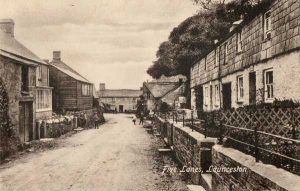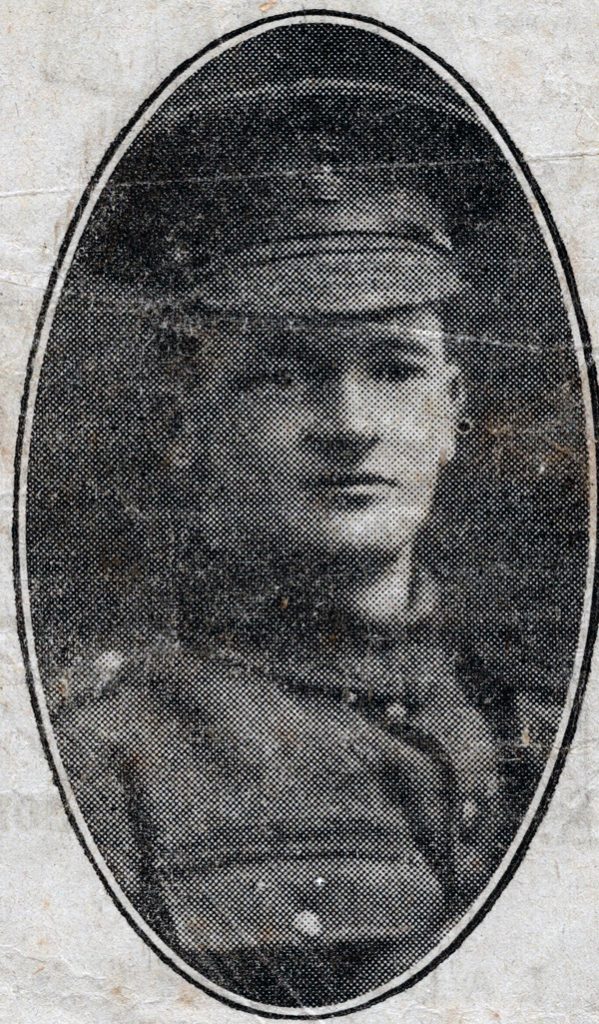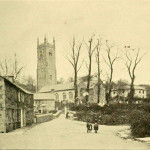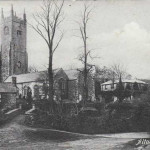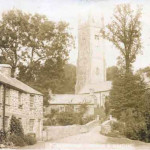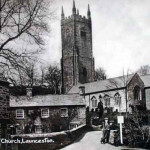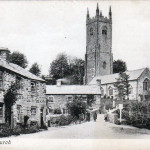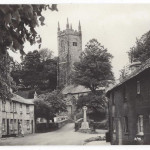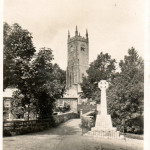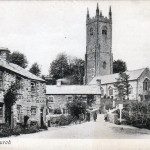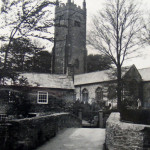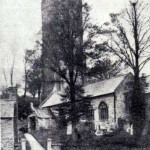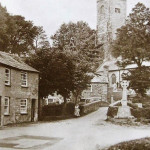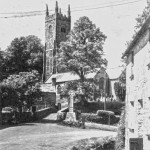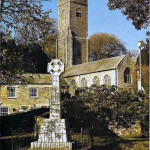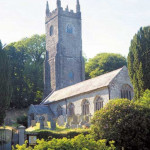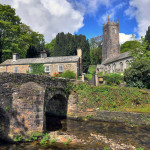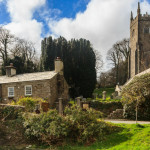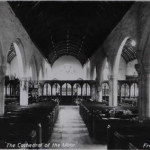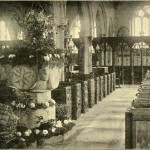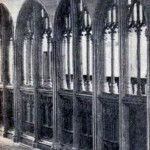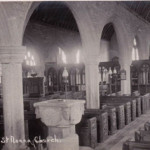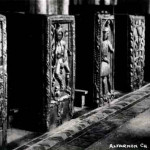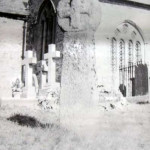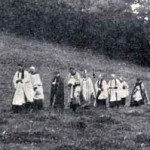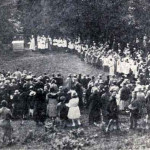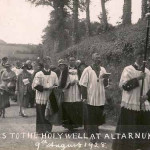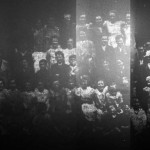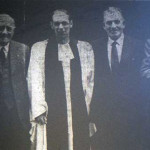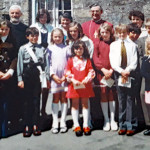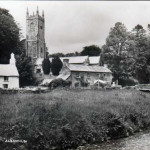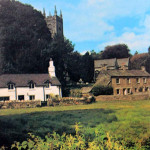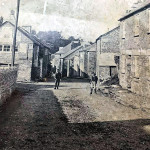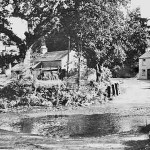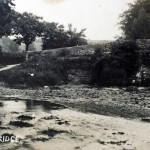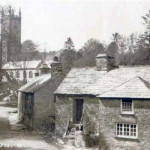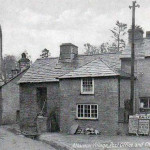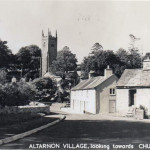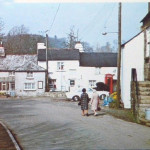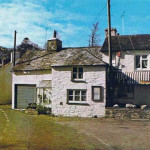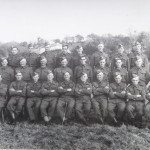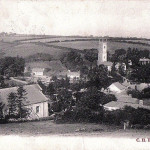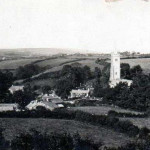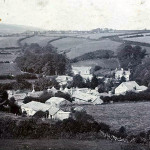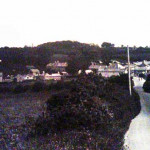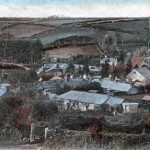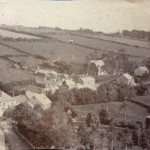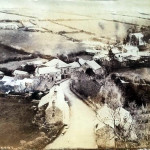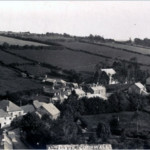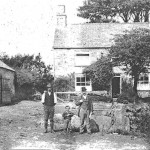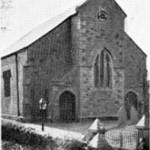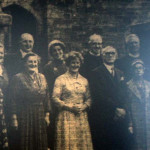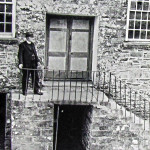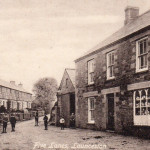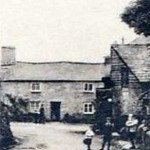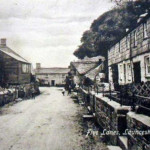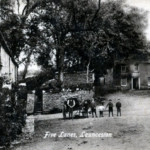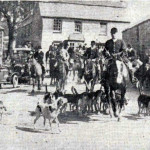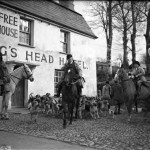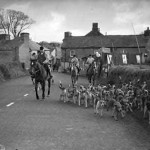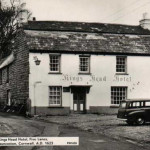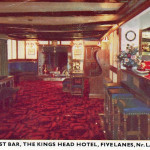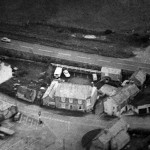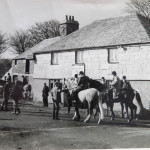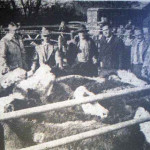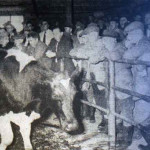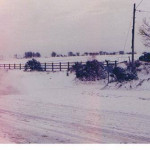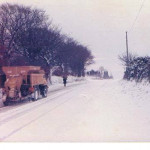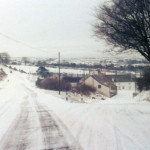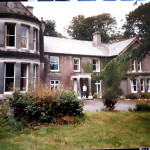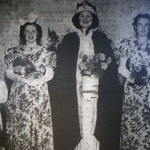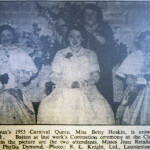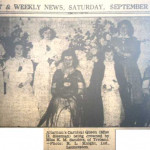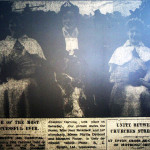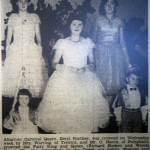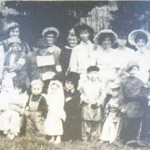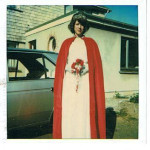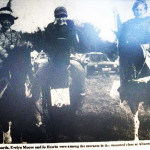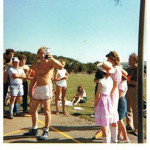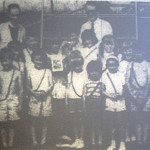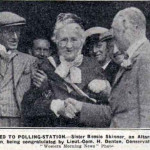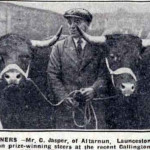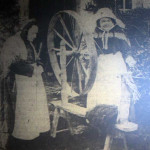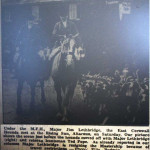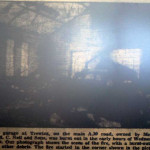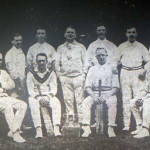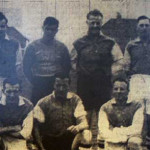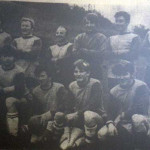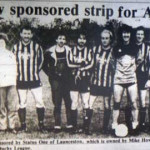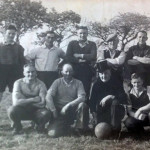.
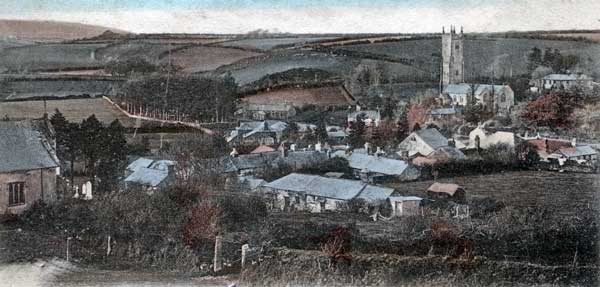
Altarnun is in the Hundred of Lesneweth, in the deanery of Trigg-major and is about eight miles west of Launceston. The name means Altar (church altar) of St Nonna. Although, Mr Hals observed in the early 19th century, that “the word Altar in this place, is not to be construed as a derivative from Altare, an altar on which offerings or sacrifices were made by fire or otherwise, at this pool.‘ But rather the chancel of the present church was a chapel pertaining to the nuns or nunnery once here, afterwards augmented and converted to a vicarage church, as it
now stands; and that the ground whereon the vicarage house is now extant, was of old the nunnery house itself, wherein those virgins resided; the stones and materials of which old house, are concerted in the new vicar-age brave mansion. And to prove this tradition, there yet appears in the fields, the channel or watercourse by which the waters of St.’ Nun’s Pool were carried into this old nunnery house in former ages.” From these circumstances he concludes that the name Altar Nun should be interpreted as a corruption of, or deviation from Alter Nun, to alter or change from one thing to another; namely, from that of a nunnery of religious votresses, to that of a parochial and vicarage church, from whence it has its denomination.
A large part of the parish lies within Bodmin Moor. Altarnun can truly be described as one of the prettiest villages in Cornwall. Across two bridges stands the Church of St. Nonna. Originally there was a Norman church built in the 12th century, but today’s church was built in the 15th century and was partly constructed of unquarried stone from the moors.
Dr Oliver wrote respecting the church: ” ‘Alternon’, supposed to be the Penponta of Domesday (although Treuint, Trewint, was also listed as being taxed), the largest parish in the county (15,014 acres), was granted to Robert, Earl of Mortmain and Cornwall, by his uterine brother King William the Conqueror. This nobleman married Matilda, daughter of Roger Montgomery, and dying in 1091 left a son, William, the successor to his property. The young Earl became the founder of St. Peter and Paul’s Cluniac Monastery of Montacute, in Somerset, and amongst other of his possessions in Cornwall, endowed it with S. Neot’s, the Rectories of Alternon and other places. When Henry I seized the crown, the Earl espoused the cause of the Conqueror’s eldest son, Robert, and for so doing he was outlawed, and his estate forfeit; still, it appears Henry suffered the above-mentioned donations to Montacute Priory to pass unmolested. With respect, Alternon, Prior Mark and his convent of Montacute transferred their rights in its church to William Briwere, Bishop of Exeter, in July 1236, and it the following year, the Bishop granted its appropriation to his Dean and Chapter.
“From a survey of the parish in 1281, we discover that the service book of the church (ordinale) was good and sufficient after the Sarum rite – that it contained a life of St. Monnac, William of Worcester, quoting the calendar of St. Michael’s Mount, affirms that her remains lay within the parochial church of Alternon.”
“A chapel at Nonnestonys in this parish was licenced by Bishop Stafford, 18th September 1400. From this parish sprang the ancient family of Trelawney. To John Trelawney and his wife Matilda had been conceded, in 1400, the privilege of an oratory at Trelawny, Treganek, and Woleston,”
The Church of St. Nun, or Nonna, is an edifice of stone in the Perpendicular style, consisting of chancel, a nave of four bays, aisles, north and south porches, and a lofty embattled western tower with pinnacles, containing five bells. It has a very fine oak roof, and a handsome rood screen, panelled and traceried. The stairs to the rood loft remain in the north aisle, and in the south aisle is an ancient piscina and bracket. The chancel contains an aumbry and two very curious paintings – dating from 1600 – of the ‘Crucifixion,’ and the ‘Administration of the Holy Eucharist.’
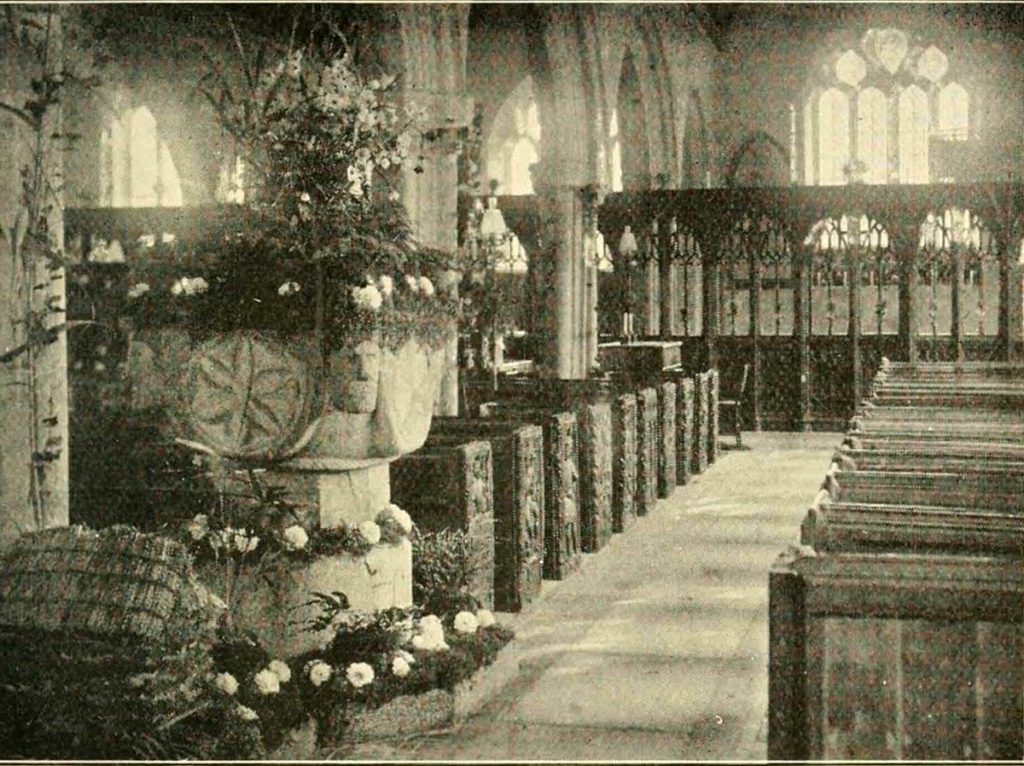
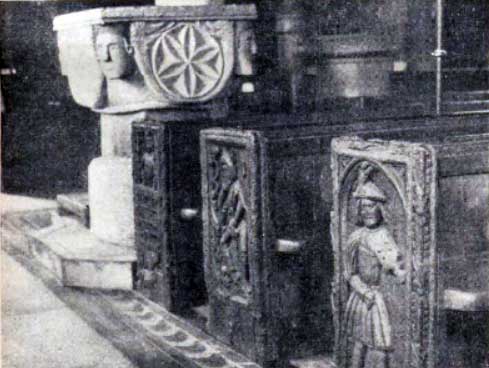
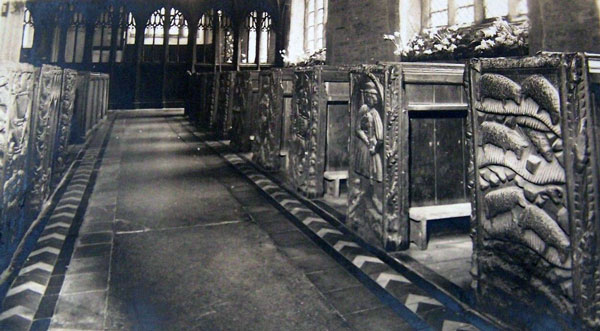
The chancel which embraces the eastern end of the side aisles, and the communion rails with the following inscription occupy the whole width of the church:-
“John Ruddle, Minister of Launceston, Preb. of Exon, and Vicar of this P’sh Anno 1684. William Prideaux and Sampson Cowl, Churchwardens.”
The fine old oak bench ends, considering their age, are in an exceedingly good state of preservation; they are of perpendicular work; 17 inches wide, 2 feet 9 inches high; each of a single slab of oak, accurately designed, and remarkably well-executed; but they show a great deal of repetition, as though the designers, having got hold of certain devices, endeavoured to ring the changes upon them to the utmost. The end next to the Font gives the legend RObART: DAYE MAKER: OF ThIS WORKE; &WILLYAM BoKIMhAM CURAT IOHN: HODGE Ch…..MD….., the last letters of the date being obliterated; but “the seats were erected after Bishop Oldham’s time, who sat at Exeter from 1507 to 1523, for on one of them are the Arms of See of Exeter, as borne at present; but down to his death the sword, which is now in pale, was placed in saltire with the keys.”
By 1864 the Church was described at the April vestry meeting as being in a very ‘ruinous state of repair’ it having been found necessary to remove several of the roof timbers, which were in danger of falling. It was proposed to re-roof, re-floor and re-seat the whole Church at an estimated cost of £600. In the end, the restoration which was completed in 1867 (report below), had a total cost of about £1,280. The rood screen was restored in 1888 at a cost of £240.
The Tower
The Tower is of three-stage, 109 feet high and contains 121 steps; embattled with crocketed pinnacles; up to second string course, including west door and window above, of transition Norman; third stage Perpendicular. It has been struck by lightning on two occasions: once in 1791, when one of the pinnacles was damaged; and again in 1810, when a similar accident 0ccured, the broken pinnacle carrying with it a great part of the battlement and crashing through the roof. The tower was also much shattered by the same storm.
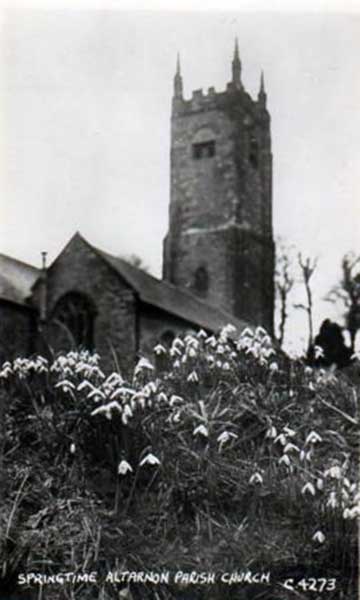
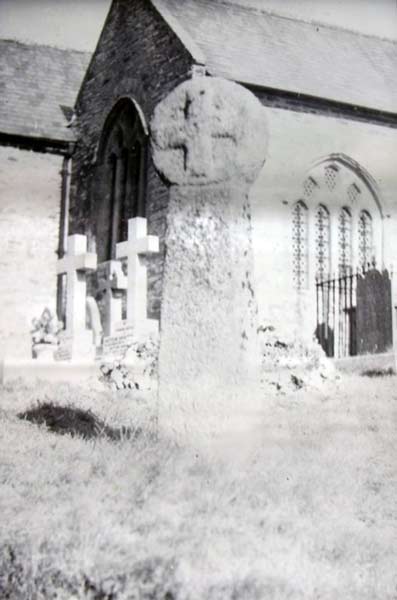
In March of 1937, an urgent appeal was launched to raise £750 needed to repair and replace the floor and roof timbers after being ravaged by death watch beetle. The rood screen also had to be rescued from this scourge.
Monuments and Epitaphs
Outside the Church against the east wall are the following plain slate tablets:-
Here lyeth ye body of ye Revd Mr Richard Wills, sometime Rector of Gidleigh in ye county of Devon, and curate of this psh., who departed this life ye 17th of May, Ano. Dom. 1712, in ye 32nd year of his age. William his infant son, and Dorcas his daughter aged 6 years died the same year.
Here lyeth the body of the Rev. Mr Joseph Hatton, vicar of this parish, who was buried April the 23rd, Anno Dom. 1729, and departed this life in the 51st year of his age.
Here lyeth ye body of ye Reverend Mr Aron Baker, M.A.; and Vicar of this parish, who was buried ye 13th of Feb. in 1749-50, and departed this life in ye 38th year of his age.
Amongst the other monuments in the churchyard, the most notable is a large tomb enclosed with iron railings, with the following remarkable inscription:-
“Sacred to the memory of Digory Isbell, who died in the Lord, 23rd June 1795, in the 77th year of his age. And of Elizabeth his wife, who exchanged earth for heaven, 8th October 1805, in the 87th year of her age. They were the first who entertained the Methodist preachers in this County, lived and died in the Connexion, but strictly adhered to the duties of the Established Church. Reader may thy end be like theirs!”
“From early life, under the guidance and influence of Divine Grace, they strengthened each other’s hands in God, uniting to bear their Redeemer’s Cross and promote the interests of his kingdom, in the face of an opposing world; thus duly estimating scriptural Christianity; in youth, health and strength their conduct was regulated by its precepts; in age, infirmity and death they were supported by its consolations and in a happy immortality they enjoy its reward.”
There is also a plain slate stone erected to another veteran Methodist Churchman, inscribed as follows:-
“This stone is erected by Henry Harris, to the memory of his Father Jonathon Harris, of Trewint in this parish. Yeoman who departed this life May 19th, 1853, aged 84 years.”
“He was for seventy years one of the Methodist Society, and died in that connexion; yet strictly adhered to his duty as a member of the Established Church.”
The following stone tablets to the Nicolls family are fixed at the end of the church:-
“In memory of Elizabeth, the wife of Thomas Nicolls of this parish, who departed this life the 9th day of July, in the year 1811, aged 89 years.”
“Here lieth the body of Thomas Nicolls of this parish, who died April 19th, 1794, in the 83rd year of his age.”
“To the memory of Edward Nicolls, Yeoman of this parish, who died Dec. 16th, 1843, aged 85 years.”
This is the Edward Nicolls who as an infant when John Wesley visited Trerithick and kneeling down, with his hand on the child’s head, Mr Wesley prayed that God’s blessing might rest upon him.
In the churchyard there is a plain granite kerbstone, inscribed:
“Robert Henry Tripp, M.A. Oxon.; for 37 years Vicar of this parish, who fell asleep March 13th, 1880, aged 72 years.”
List of Altarnun Vicars from 1613-1901
1613 Beard, Nathaniel
— Beard, Thomas
1679 Ruddle, John
1699 Blackburn, Launcelot
1717 Hatton, Joseph
1729 Kendall, James
1732 Burrell, Thomas
1743 Baker, Aaron
1749 Amphlett, Joseph
1757 Trist, John.
1776 Derisley, Thomas
1795 Booth, Livingstone
1806 Hart, Samuel
1842 Tripp, Hobert Henry
1876 Power, John
1887 Malan, Alfred Henry
The Church town is situated 6 miles south-west of Egloskerry, 8 miles west of Launceston, and 12 miles north of Callington, and the parish is surrounded by Trewen, Lewannick and North Hill on the east, St. Cleer and St. Neot on the south, St. Breward on the west, and St. Clether and Laneast on the north divided by the River Inney.
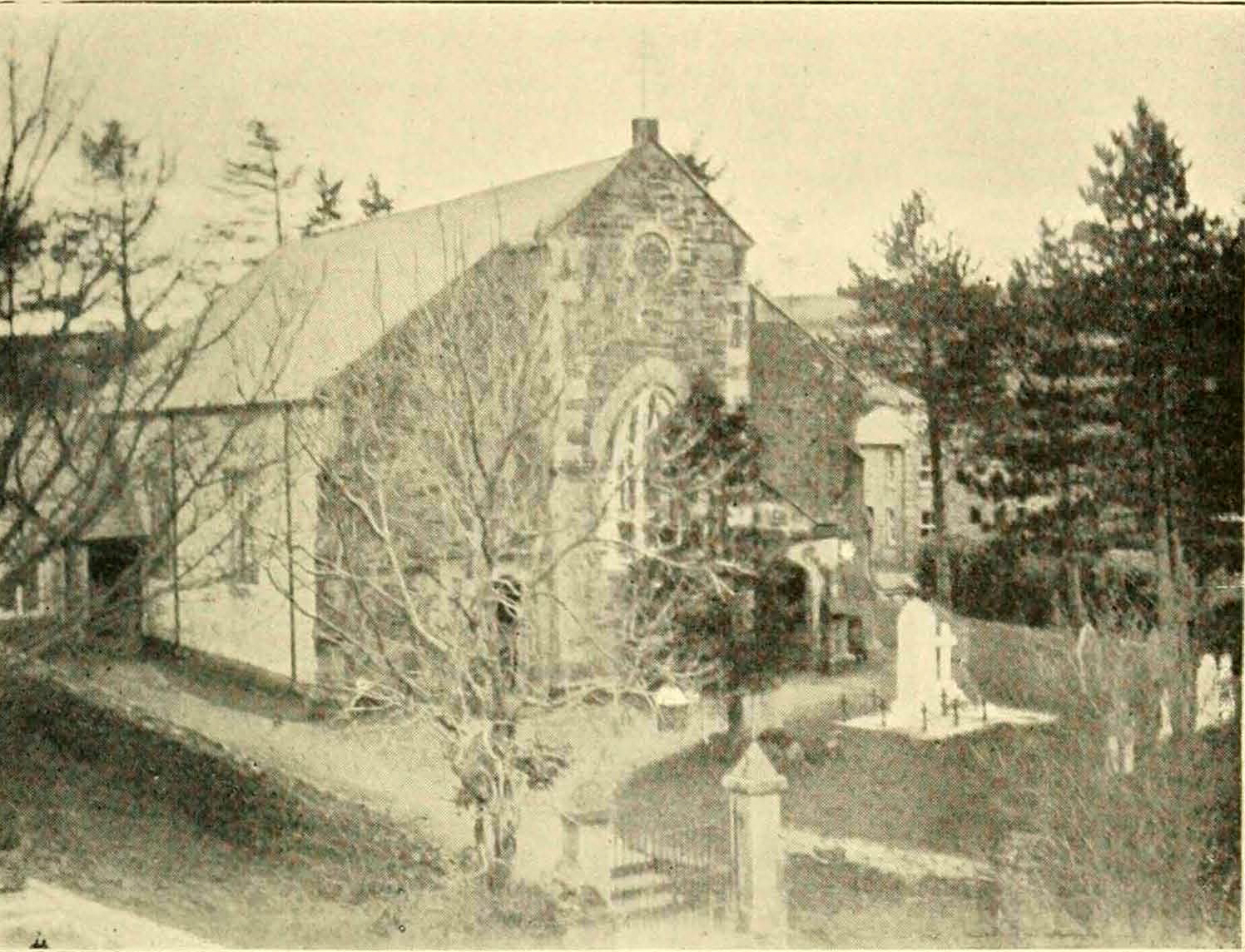
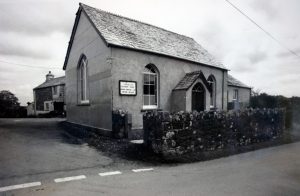
The Wesleyans have a very large Chapel, Vestries and Burial Ground (above left). There is also a Chapel at Bowithick. There was also a Bible Christian Chapel at Trecollas (above right) but this has now been converted into a private home.
East Cornwall Times, 16 April, 1859. DONATION. John Grigg, Esq., of Philadelphia, who when a boy resided in the Parish of Altarnun, has given the liberal sum of £50. towards the erection of the new Wesleyan Chapel in the village of Altarnun.
East Cornwall Times, 1 October 1859. Chapel Opening. The New Wesleyan Chapel At Altarnun will be opened for Divine Worship on Thursday next, October 26th, 1859, when the following Services will be held. The Revd. John Horsey (Independent Methodist) will preach at 11 in the forenoon. A cold Collation will be provided for Strangers at 1 o’clock. The Revd. Nathaniel Alston will preach at 2 ½ pm. A Public Tea (which will be gratuitously provided), will be held at 4 o’clock, at 1s. for Adults and 6d for children. Revd. Samuel Lucas will preach at Six o’clock. Sept 29 1859.
East Cornwall Times, 8th October, 1859. Wesley Chapel at Altarnun. On Thursday last, three Sermons were preached in the New Chapel. The weather was very fine and a moderate quantity was assembled to partake of the Collation which was provided for Strangers at 1 o’clock at 1s. each. The Harmonium was played by Mr F. T. Hamlyn and gave great satisfaction. The Tea which was provided in the old chapel was very good, and upwards of 800 did ample justice to the tea and cake, there being plenty of cream, and all of which was gratuitously provided by ladies in the neighbourhood. The new chapel lit up with Petroline in the evening presented a very striking appearance, and the collections were very good. The sudden death of Mr John Tegg, one of the masons, caused a great damp to come over the village. It appears that he was standing at the Chapel door, at about 3 ½ when he fell down in a fit of apoplexy.
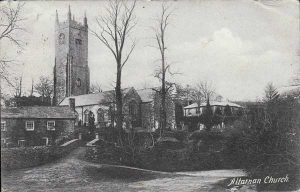
The principal Villages or Hamlets are the Churchtown, which is situated on the north side of the Inney, and Penpont on the south side also; Tredaule, Trevague, Tregunnon, West Carne, Trethinna, Treween, Bowithick, and Fivelanes (above right). At the latter place, which is a noted junction of main roads, large fairs were held annually on the Monday week after June 24th, and on the last M0nday in September. The market at Five Lanes continued until its closure in 1988. Part of Bolventor and area were also in Altarnun parish until the mid 19th century.
An old Cornish song of the Altarnon volunteer has the verse :
O Altarnon ! O Altarnon ! I ne’er shall see thee more,
Nor hear the sweet bells ringing, nor stand in the church door,
Nor hear the birds a-whistling, nor in the Inny stream
See silver trout glance by me, as thoughts glance by in dream.
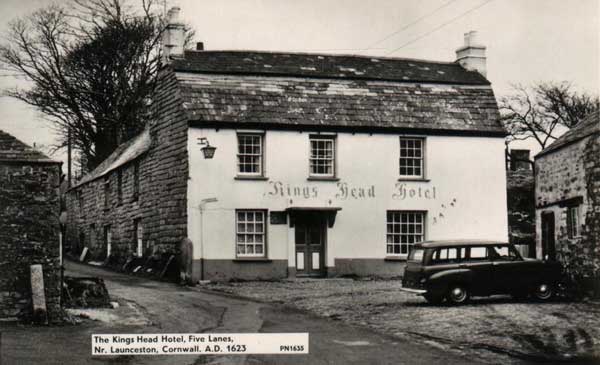
The Kings Head hotel dates back to 1623 and is one of the oldest inns on Bodmin Moor.
In 1911 on land given by the Tredaule Estate, a Unionist Hall was built by the Kittow family opposite the Wesleyan Chapel. The hall cost £1,000 to build and was opened in 1912.
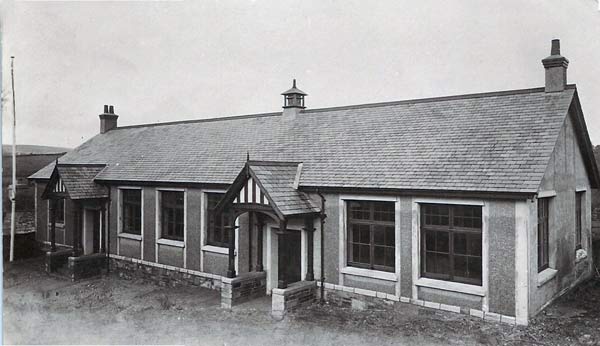
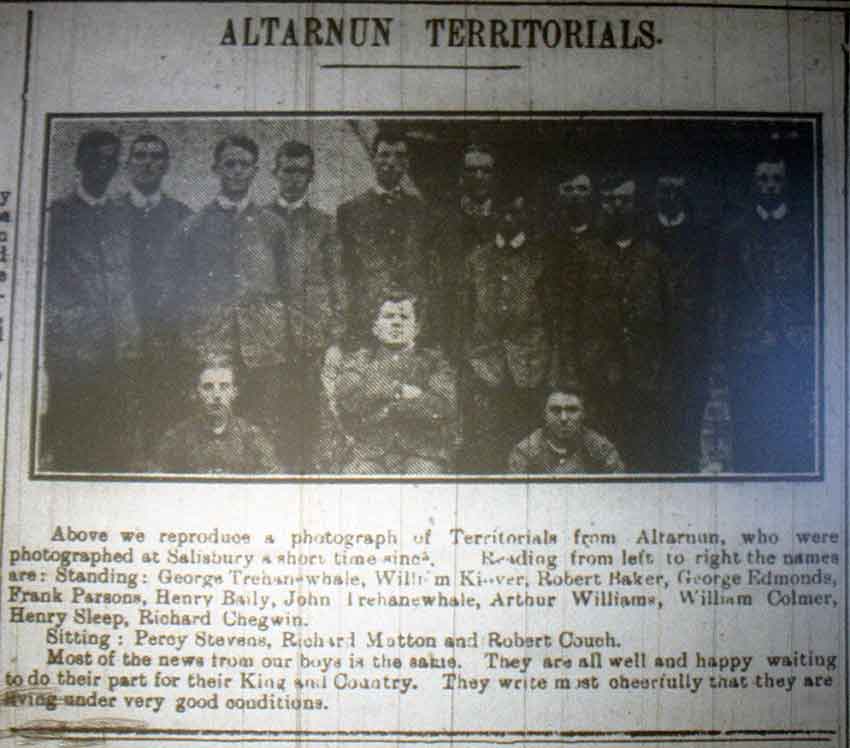
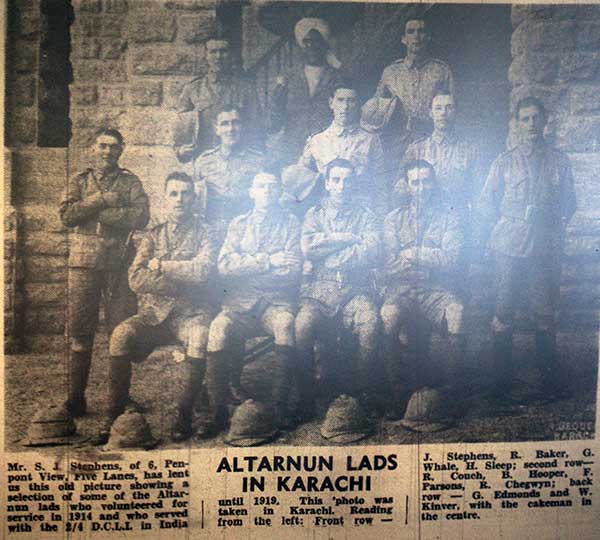
Altarnun’s Fallen from World War One
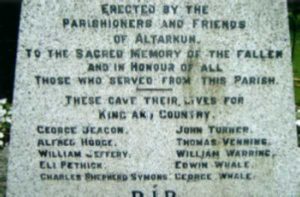
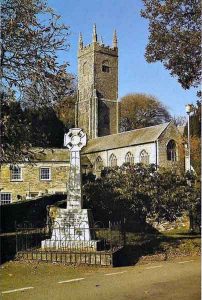
Parishioners and Friends
of Altarnun
To the sacred memory of the fallen
And in honour of all
Those who served from this parish
George Deacon John Turner
Alfred Hodge Thomas Venning
William Jeffery William Warring
Eli Pethick Edwin Whale
Charles Shepherd Symons George Whale
.
George Trehane Deacon
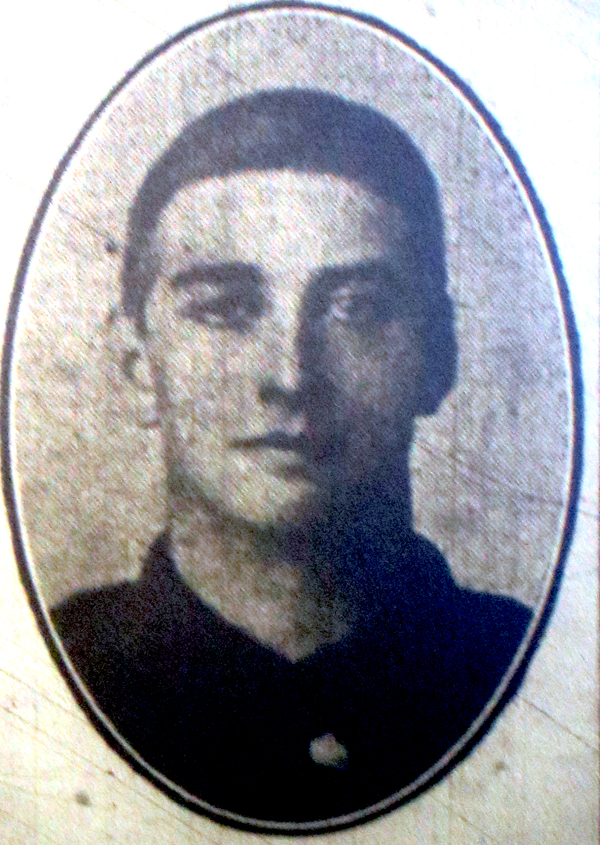
George was born in 1883 to John and Eliza Deacon at Rosehill Villa, Altarnun. His Father was a Carpenter. The family moved to live at Chapel Road Cottage, Egloskerry by 1901 and George was working as a Domestic Gardener. The family were living at Killicoff, Egloskerry by the 1911 census, but George was now living in Falmouth and working working as a Postman. He first enlisted with the Duke of Cornwall’s Light Infantry (Regimental No. 7860) in 1902 serving in the colours for three years before becoming a Reservist for nine years. At the outset of the war in the August he was called up to serve with the 1st Battalion ‘A’ company of the D.C.L.I. part of 14th infantry Brigade, 5th Division.
He was killed in Action on the 5th of December 1914 by a bullet. He is commemorated at the Ypres (Menin Gate) Memorial, Ypres (Ieper), West Flanders (West-Vlaanderen), Belgium and also on the Egloskerry and Falmouth war memorials.
Extract of a letter to Mrs Deacon from a stretcher bearer of A. Co. 1st DCLI:-
We were all quiet in our trenches (at 2 pm. on December 5th) when two shots rang out, and I was called for, to find your son badly hit. I did my best for him but I am sorry to say that he was dead within five minutes from the time he was wounded. We buried George during the night, as it was not safe to do so during the day. You can rest assured that he was buried with a suitable honour for a soldier. We have placed a cross on his grave with a suitable inscription, with his name and regiment in print. Yours very sincerely, Lance Corporal T E Rendle.
Alfred Hodge
Alfred was born 1899 to Thomas and Christiana Hodge at Jolls Ground, Trewint, Altarnun. His Father worked as an Ordinary Agricultural Worker. He enlisted at Launceston with the Princess Charlotte of Wales’s (Royal Berkshire Regiment) as a Private with the 5th Battalion (Regimental No. 34703). He was killed in action during the Battle of Cambrai on the 30th of November 1917. His body was never identified but his name is commemorated on the Cambrai Memorial Louverval, Departement du Nord, Nord-Pas-de-Calais, France, Plot: Panel 8 and on the Altarnun War Memorial.
The Battle of Cambrai was a British attack followed by the biggest German counter-attack against the British Expeditionary Force (BEF) since 1914, in the First World War. Cambrai, in the département of Nord, was an important supply point for the German Siegfriedstellung (known to the British as the Hindenburg Line) and capture of the town and the nearby Bourlon Ridge would threaten the rear of the German line to the north. Major General Henry Tudor, Commander, Royal Artillery (CRA) of the 9th (Scottish) Division, advocated the use of new artillery-infantry techniques on his sector of the front. During preparations, J. F. C. Fuller, a staff officer with the Tank Corps, looked for places to use tanks for raids. General Julian Byng, commander of the British Third Army, decided to combine both plans. The French and British armies had used tanks in mass earlier in 1917, although to considerably less effect.
After a big British success on the first day, mechanical unreliability, German artillery and infantry defences exposed the frailties of the Mark IV tank. On the second day, only about half of the tanks were operational and British progress was limited. In the History of the Great War, the British official historian, Wilfrid Miles, and modern scholars do not place exclusive credit for the first day on tanks but discuss the concurrent evolution of artillery, infantry and tank methods. Numerous developments since 1915 matured at Cambrai, such as predicted artillery fire, sound ranging, infantry infiltration tactics, infantry-tank co-ordination and close air support. The techniques of industrial warfare continued to develop and played a vital part during the Hundred Days Offensive in 1918, along with replacement of the Mark IV tank with improved types. The rapid reinforcement and defence of Bourlon Ridge by the Germans, as well as the subsequent counter-stroke, were also notable achievements, which gave the Germans hope that an offensive strategy could end the war before American mobilisation became overwhelming.
William was born in 1889 in Launceston. He enlisted with the Duke of Cornwall’s Light Infantry (Regimental No. 26327) serving with the 7th Battalion. He was killed in action possibly during the Battle of Langemarck on the 16th of August 1917. His body was never identified but his name is commemorated on the Tyne Cot Memorial as well as the Altarnun and Roche War Memorials. At the time of his death, he had been living at Roche.
The Battle of Langemarck (August 16th-18th, 1917) was the second Anglo-French general attack of the Third Battle of Ypres, during the First World War. The battle took place near Ypres in Belgian Flanders, on the Western Front against the German 4th Army. The French First Army had a big success on the northern flank from Bixschoote to Drie Grachten and the British gained a substantial amount of ground northwards from Langemark to the boundary with the French.
The attack on the Gheluvelt Plateau on the right (southern) flank captured a considerable amount of ground but failed to reach its objectives. German counter-attacks recaptured most of the lost territory during the afternoon. The weather prevented much of the British programme of air co-operation with the infantry, which made it easier for German reserves to assemble on the battlefield.
An unusually large amount rain in August, poor drainage and lack of evaporation turned the ground into a morass, which was worse for the British and French, who occupied the lower-lying ground and attacked areas which had been frequently and severely bombarded. Mud and flooded shell holes severely reduced the mobility of the infantry and poor visibility hampered artillery observers and artillery-observation aircraft. Rainstorms and the costly German defensive success during the rest of August led the British to stop the offensive for three weeks.
In early September, the sun came out and with the return of a breeze, dried much of the ground. The British rebuilt roads and tracks to the front line transferred more artillery and fresh divisions from the armies further south and revised further their tactics. The main offensive effort was shifted southwards and led to success on the Gheluvelt Plateau on September 20th, 26th and October 4th, before the rains returned.
Eli Pethick
Eli was born in 1891 to Joseph and Elizabeth Pethick at Trewint, Altarnun. His Father was a Manganese Miner in 1891 but by 1901 was working as an Ordinary Agricultural Worker. Eli joined the Royal Navy (Service No. J1209) on the 22nd of March 1909 on a 12 year service period. He was serving aboard the Submarine ‘HMS Maidstone’ (D2) as an Able Seaman which was lost in the North Sea on the 1st of December 1914. D2 was built by Vickers, Barrow and was launched on the 25th May 1908. D2 put to sea on the 24th, under the command of Lieutenant Commander Head. The submarine failed to return. It is believed that she was sunk on, or around, the 25th of November, following an encounter with a German Torpedo Boat. near Borkum Island, Germany. 26 crewmen killed were killed there were no survivors. At the time of his death, his Parents were residing at 6, Dunnis Terrace, Lower Compton, Plymouth. His body was never recovered and he is commemorated on the Plymouth Naval Memorial, Plot: 2 and on the Altarnun War Memorial.
Charles was born in July 1892 at Brazacott the only son of William and Norah (nee Shepherd) Symons. His father was a farmer first at Brazacott, North Petherwin, then the family moved to farm at Honiton Farm, South Petherwin by 1901. On leaving school, Charles went to work on his uncle’s farm, William Pearse at Trerithick, Altarnun. He was a local Wesleyan preacher for the North Hill Circuit. It was whilst living at Trerithick that he joined the 1st Devon Yeomanry enlisting at Exeter. He was then transferred to the Devonshire Regiment, serving as a Private (Regimental No. 345310) with the 5th Battalion (Territorials) of the 29th Division. After training, he was drafted to Egypt in 1916 where he served in the fighting against the Turks. He was killed in action during the Battle of Amiens on the 24th of August 1918. His body was never identified but his name is commemorated on the Vis-en-Artois Memorial, Panel 4, British Cemetery, Haucourt, Departement du Pas-de-Calais, Nord-Pas-de-Calais, France and on the Altarnun War Memorial and his name is to be added to the Gulworthy War Memorial. At the time of his death, his parents were residing at Woodovis, Tavistock, Devon.
The Battle of Amiens, also known as the Third Battle of Picardy (French: 3ème Bataille de Picardie), was the opening phase of the Allied offensive which began on 8 August 1918, later known as the Hundred Days Offensive, that ultimately led to the end of the First World War. Allied forces advanced over 11 kilometres (7 mi) on the first day, one of the greatest advances of the war, with Henry Rawlinson’s British Fourth Army playing the decisive role. The battle is also notable for its effects on both sides’ morale and the large number of surrendering German forces. This led Erich Ludendorff to describe the first day of the battle as “the black day of the German Army”. Amiens was one of the first major battles involving armoured warfare.
John Turner
John was in 1879 to John and Thomasine Turner at Webbs Cottage, Hendra, Altarnun. His father was a Mason. John joined the Royal Navy as a Chief Stoker (Service No. 282625). He was serving aboard ‘ HMS Dartmouth’ when he was killed when a boiler exploded on the 15th of March 1915. He is commemorated on the Plymouth Naval Memorial and the Altarnun and Bolventor War Memorials.
Thomas Courtice Venning
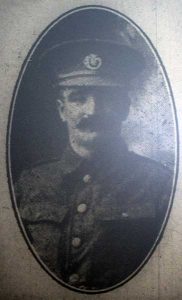
Thomas was born in 1879 at Chillaton, Devon to John and Selina Venning. His father was a Farmer, farming a smallholding at Higher Treween. By 1911 he was working for Henry Michells at Trebullom Farm, Altarnun as a Waggoner. He was a member of the Wesleyan Chapel, being also a Sunday school teacher, and Band of Hope at Altarnun. He enlisted at Launceston with the Duke of Cornwall’s Light Infantry 6th Battalion (Regimental No 26543). He was killed in action by shell fire at the Battle of Arras on the 6th of May 1917 and is buried at the Wancourt British Cemetery, Wancourt, Departement du Pas-de-Calais, Nord-Pas-de-Calais, FrancePlot: I. C. 5. and is also commemorated on the Altarnun War Memorial.
In 1917the 6th Battalion fought in The German retreat to the Hindenburg Line, The First and Third Battle of the Scarpe at Arras, The Battle of Langemark and The First and Second Battle of Passchendaele.
The Battle of Arras (also known as the Second Battle of Arras) was a British offensive during the First World War. From 9 April to 16 May 1917, British, Canadian, South African, New Zealand, Newfoundland, and Australian troops attacked German defences near the French city of Arras on the Western Front. There were major gains on the first day, followed by stalemate. The battle cost nearly 160,000 British casualties and about 125,000 German casualties.
William Warring
William was born in 1882 to John and Margaret (nee Couch) Warring at Rosemayne Farm, Altarnun. His father worked for Mr James Smale as an Agricultural Labourer. At the time of the 1911 census, William was working for Mr Edward Baker, Trezibbet Farm, Altarnun as a Waggoner. William enlisted at Hilsea, Hampshire with the Dorset Regiment (Regimental No.18403) but was transferred to the Duke of Edinburgh’s (Wiltshire Regiment) 2nd Battalion (Regimental No. 26626). He was killed in action on April 9th, 1917 as Thomas Venning above, at the Battle of Arras.
The 2nd Battalion spent the first three months of 1917 around Arras. On the 9th April, they took part in the attack on the Hindenburg Line very few men reached the objective and those that did found that the German wire was undamaged. On the 11th April, they came out of the line weaker by 16 officers and 363 other ranks.
He is buried at the Neuville-Vitasse Road Cemetery, Neuville-Vitasse, Departement du Pas-de-Calais, Nord-Pas-de-Calais, France, Plot: C. 21. He is also commemorated on the Altarnun War Memorial.
Edwin John Whale
Edwin was born in 1894 to John and Mary (nee Downing) Whale at Penpont, Altarnun. His father was a Carpenter & Joiner working for himself. On leaving school he went to work as a General Work Domestic for Mr John Kittow of Tredaule House but in July 1911 he joined the Royal Navy as a Boy Servant, (Service No. L2947) however he contracted syphilis and was invalided out the following year in July 1912. At the age of 19, he emigrated to Canada arriving at Halifax, Nova Scotia aboard the ‘Hesperian’ on the 3rd of April 1913. On the18th of February 1916, he enlisted with the Canadian Infantry (Saskatchewan Regiment, Regimental No. 886399) serving with the 28th Battalion. On his enlistment form, he was showing as working as a Farmer living in Prince Albert, Saskatchewan. His sister, Mrs Mary Jane Downing was listed as his next of kin and his residence as being Shobrooke, Crediton, Devon. He was killed in action on the 21st of August 1917 in the Battle for Hill 70.
The Battle of Hill 70 was a localized battle of World War I between the Canadian Corps and five divisions of the German Sixth Army. The battle took place along the Western Front on the outskirts of Lens in the Nord-Pas-de-Calais region of France between 15 August 1917 and 25 August 1917. The primary objective of the assault was to inflict casualties and draw German troops away from the 3rd Battle of Ypres, rather than to capture territory.
To achieve this objective, the Canadian Corps executed an operation designed to first occupy the high ground at Hill 70 quickly and then establish defensive positions from which combined small arms and artillery fire, some of which used the technique of predicted fire for the first time, could be used to repel German counterattacks and inflict as many casualties as possible. A later attempt by the Canadian Corps to extend its position into the city of Lens itself failed. Both sides suffered high casualty rates and Lens remained under German control. In both the German and the Canadian assessments of the battle was that it succeeded in its attritional objective.
The battle consisted of extensive use of poison gas by both sides, including the newly introduced German Yellow Cross shell containing the blistering agent sulfur mustard. Ultimately, the goals of the Canadian Corps were only partially accomplished. The Canadians were successful in preventing German formations from transferring local men and equipment to aid in defensive operations in the Ypres Salient but failed to draw in troops from other areas
His body was never identified but he is commemorated on the Vimy Memorial, Pas de Calais, France. He is also remembered on the Shobrooke War Memorial.
George Whale
George, the younger brother of Edwin, was born in 1897 to John and Mary (nee Downing) Whale at Penpont, Altarnun. Both his parents had passed away by 1911 and he was living with his eldest Sister Mary Downing and her Husband John Downing at the School House, Shobrooke, Crediton. He enlisted at Bodmin initially with the Hampshire Regiment (Regimental No 34059) but was subsequently transferred to the Oxfordshire and Buckinghamshire Light Infantry 1st Bucks Battalion (Regimental No.33547). He was killed in action in Italy fighting against the Austrians on the 29th of October 1918.
At the end of September, the British and French Corps was withdrawn to prepare for an offensive on the Piave, leaving only the 48th Division and the 24th French Division on the Plateau to engage the attention of the enemy. On the night 28th/29th October, the Austrians vacated their front-line system on the Asiago Plateau and retired to a prepared position 3,000 yards in the rear at the foot of the mountains that rose on the northern edge of the Plateau. For three months they had been working on this line in anticipation of the coming winter and had given it the name of Winter Stellung. The front line thus vacated was at once occupied by the Allied troops, the 48th Division being in the centre, with the 24th French Division on the right, and 20th Italian Division on the left.
He is buried at the Barenthal Military Cemetery, Asiago, Provincia di Vicenza, Veneto, ItalyPlot: Plot 2. Row A. Grave 8.
Altarnun’s fallen from World War Two
Joyce Chapman
Frances Joyce Chapman, known as Joyce, was born on February 1st, 1918. She was the daughter of Samuel George Chapman (born 1884) and Rosalie Hellen (nee Johns), born 1885, married 1908.
Her parents lived in Tregenna, Treneglos in 1911 and they had two children born there – a daughter Elizabeth Anne born in 1909 and a son born in 1910 who was named after his father but only survived three months and is buried at Treneglos. Elizabeth married in the summer of 1944 to Reginald T Pethick. Joyce had another elder sister, Edith, who was born in 1916 and a younger brother Jimmy (Harold James) who was born in 1928. The family moved to Neway Hill Cottage in the 1930s and remained there for some years.
In the 1939 register, however, Joyce was living at The School House in North Hill with the family of Owen Mitchell, a stonemason. Joyce provided some sort of domestic assistance to Owen’s wife, Beatrice.
Joyce died in Southampton in 1944 aged 26. It is understood that Joyce died of pneumonia and had worked for the NAAFI organisation probably at a munitions factory in Southampton but no documentary evidence has been found. Joyce is not recorded on the Commonwealth Grave War Commission’s database which in addition to military casualties includes civilian deaths where the cause of death was directly attributed to the war or where the deceased contributed materially to the war effort. Joyce knew Doreen Sandercock well and both she and Doreen were amongst the many local young women who worked for the war effort far from home.
We are grateful to Peter Allen of the Altarnun Local History Society who has provided most of this biography of Joyce.
Anthony McDiarmid
Anthony, or Tony as he was known, was born 1919 to Arthur Hallam and Esther McDiarmid at West Farm, Altarnun. He had emigrated in 1939 to Australia from Southampton aboard the ‘Moreton Bay’ arriving in Sydney. He was listed as being a groom. He enlisted with the AIP serving with the Infantry (Service No. NX31697). On the 22nd of June 1942, some weeks after the fall of Rabaul to the Japanese, a large number of Australian prisoners including Tony were embarked from Rabaul’s port on the SS Montevideo Maru. Unmarked as a POW ship, she was proceeding without escort to the Chinese island of Hainan, when she was sighted by the American submarine USS Sturgeon near the northern Philippine coast on the 30th of June. Not realising that the ship was carrying POW’s Sturgeon fire four torpedoes which sank the ship in less than 11 minutes. Tony drowned and his body was never recovered.
Howard Phillips
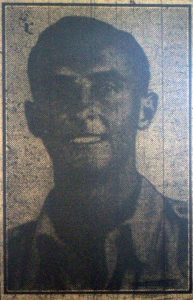
Howard was born in 1923 to William and Elizabeth Phillips at Altarnun. He enlisted with the Queens Own Royal West Kent Regiment (Regimental No. 5349383) serving with the 1st Battalion as a Lance Corporal. He was later promoted to Sergeant. He died on the 14th of December 1944 of his wounds sustained whilst fighting in Italy and is buried at St. Nonnas Church, Altarnun.
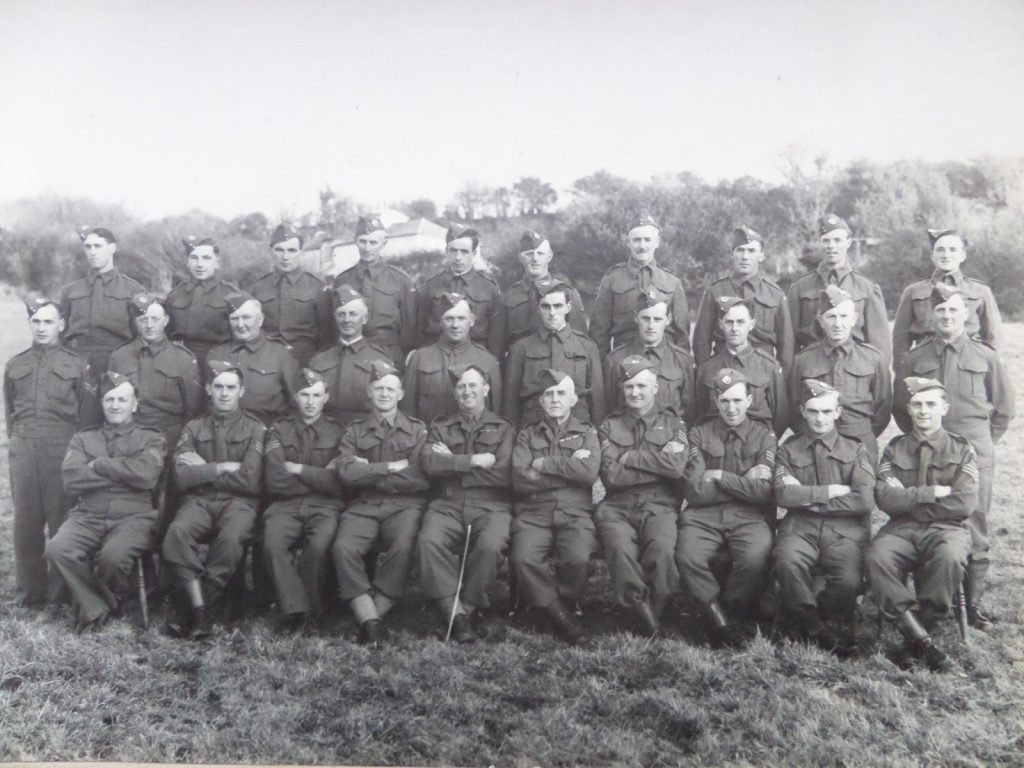
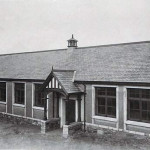
The Trelawny Family
The barton of Trelawny is situated within the Altarnun parish, just west of the Rising Sun Inn, and it is from this place the old and famous Trelawny family hale from. It was their original seat, and the barton, with a deer park, was the residence of Sir John Trelawny, a distinguished military character, back so far as the reign of Henry V. Over one of the gates of Launceston were the arms of that monarch, and under them this distich:-
“He that will do aught for mee,
Let hym love well Sir John Trelawny.”
He was M.P. for the County and one of the coroners, which office in former times was conferred upon the most eminent knights in the shire alone. Tradition says “The greatest part of the stones that built the present Church and Tower of Alter Nun were brought from the dilapidated walls of Trelawny; and much of the oak timber that roofs the same was also cut and carried from that barton.”
“And shall Trelawny die?
And shall Trelawny die?
Twenty thousand Cornishmen
Will know the reason why?”
This famous chorus has its origins from the time of James II, when Jonathon Trelawny was imprisoned in the Tower of London, as one of the seven bishops. This chorus was sung in his honour by stalwart Cornishmen as they prepared to march to the Tower in order to free him.
Peter Joll
At the time of Charles II, there lived in the parish a Peter Joll, Jowle, or Jowell, who is reported to have been the clerk or deacon of the Church, and was 150 and odd years old when he died; and at the age of 100 years had new black hairs that grew out on his head amongst those that long before were white with age, and then also new teeth grew up in his jaw, in the places of those that many years before were fallen out of his head.” That there was such a person as Peter Joll there is no doubt, as the title deeds to ‘Jolls Ground,’ show from some 400 years previous.
West Carne
At West Carne there are the remains of a small Roman encampment; and on the opposite site hill, another is plainly visible to the naked eye. On another nearby field called ‘Church Park’, there can be found remains of ruined foundations, said to be those of a Church that was once intended to be built; hence it is called Church Park. West Carne house itself is probably one of the oldest in the parish. Giving evidence is a saw cut granite lintel over a window which has these words:-
“ANNO DOMMYNE 1573 JOHN MORYDEG.”
At the western end of the house, there was formerly a granite pinnacle in the form of a cross, which had fallen down.
Visits: 779

